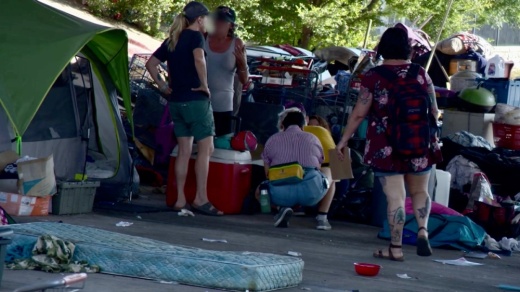Austin's Housing-Focused Encampment Assistance Link, or HEAL, initiative was launched by City Council in February to clear four "high-priority" encampments throughout the city identified as public safety risks. Months of planning and outreach led to the clearing of those four sites—East Cesar Chavez Street near the Terrazas Branch Library, an underpass at Ben White Boulevard and Menchaca Road, West Cesar Chavez Street downtown, and now the US 183 at Oak Knoll Drive underpass—from mid-June through August.
The city said 23 people living at the Northwest Austin encampment beneath US 183 agreed to move into shelter Aug. 31.
"We have been on a long road to comprehensively address both longstanding challenges related to homelessness in our community, as well as new challenges created by the 2019 camping ban repeal, and I believe we are making steady progress on this issue," District 6 Council Member Mackenzie Kelly said in an emailed statement. "Staff will continue to address sites across the city, and we expect to see other sections along [US] 183 addressed in the near future."
In total, HEAL Phase 1 ended up moving 143 people from all four targeted encampments into the city's Northbridge and Southbridge shelters, which are converted hotels in north and south Austin, for supportive case management and rapid rehousing enrollment.
“The HEAL Initiative opens an important door for people who have been living unsheltered for far too long,” Homeless Strategy Officer Dianna Grey said in a statement. “To move from an encampment to a secure, private room has an immediate and dramatic impact on their health and safety, and their ability to focus on their next steps.”
The February resolution beginning the HEAL process also called for city staff to plan for second and third phases building off of Phase 1. When that effort was nearing completion earlier in August, council moved to fund the next phase of the potentially multistage plan.
Council's mid-August budget deliberations included a $6 million directive from District 5 Council Member Ann Kitchen, who sponsored the original HEAL resolution, that will see the city work to shelter at least 200 people in fiscal year 2021-22 through HEAL Phase 2. The measure was supported across the dais, with District 7 Council Member Leslie Pool praising the program's "tremendous results" this year and Kelly saying she hoped to see HEAL become "a model of use" nationwide.
The scope of the second phase and the locations of the encampments to be targeted are not yet determined, but Kitchen's budget amendment called for a start date before Nov. 1. During budget talks, Grey said those involved in the HEAL process will also likely report on their findings and potential adjustments based on the first four site clearings to council before moving onto future phases.
"One of the things that was contemplated in the resolution that established the HEAL initiative was that after we complete these four sites we would come back to council with feedback about what we learned, any revisions or improvements that might be available to us or necessary to maximize the effectiveness of the project, and we would anticipate doing that after we complete site four," Grey said Aug. 12.
The end of the first HEAL process took place amid the ongoing fourth and final phase of Austin's Proposition B camping ban enforcement, and one day before a statewide camping ban went into effect.
House Bill 1925 was signed by Gov. Greg Abbott earlier this year after its passage in the Texas Legislature's regular session and became effective Sept. 1. The law now prohibits camping in public in cities throughout Texas, bans the creation of sanctioned encampments in public without the state's permission, and blocks such camps from being set up in public parks.
The designated campsite strategy is one City Council spent weeks considering earlier this year, with asks for city staff to find properties that could be used as campsites and estimate related spending needs. Eventually, Mayor Pro Tem Natasha Harper-Madison and District 8 Council Member Paige Ellis jointly expressed their opposition to the concept in late July after city staff narrowed a list of potential encampment sites to locations in their districts. Council has since seemed more engaged with other rehousing strategies such as hotel conversions, which some members have pointed to as being more sustainable and cost-effective options.
In the meantime, rehousing efforts through other Austin-area service providers are continuing. The city recently passed a milestone for housing efforts established during this spring's Summit to Address Unsheltered Homelessness in Austin, which saw community stakeholders set a goal of rehousing 3,000 people over three years. That overall plan features periodic benchmarks along the way including a call for 200 people to be rehoused through August.
Information on that progress is expected to be compiled and available on nonprofit Ending Community Homelessness Coalition's housing dashboard in the coming weeks, following a similar process based around the Summit Plan's first goal of rehousing 100 people through June. The city and local service providers failed to meet that mark, with a reported 79 people moved into stable housing between April 1 and June 30, according to Summit Plan partners.





